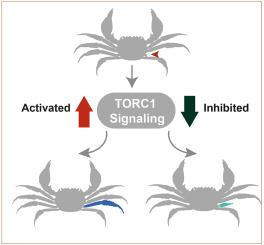Regenerative growth in Eriocheir sinensis is driven by Slc7a5-TORC1-regulated cell signaling
IF 2.1
3区 生物学
Q2 DEVELOPMENTAL BIOLOGY
引用次数: 0
Abstract
Limb regeneration is a widespread phenomenon among animals, yet the underlying molecular mechanisms remain incompletely understood. Crustaceans like the Chinese mitten crab (Eriocheir sinensis), possess the remarkable ability to regrow lost limbs through a highly regulated regenerative process. In this study, we investigated the molecular mechanisms underlying limb regeneration in E. sinensis by integrating morphological and histological analyses, spatiotemporal mRNA expression profiling of TORC1 pathway genes, and RNA interference of Slc7a5 and TOR genes. Our results demonstrated that key genes within the TORC1 pathway, including Vatb, Rraga, Rragd, TOR, and S6K1, exhibit distinct expression patterns at different stages of limb regeneration, varying across developmental periods. Furthermore, in-situ hybridization and targeted knockdown of Slc7a5 and TOR genes significantly affected the rate of limb regeneration, highlighting their crucial roles in promoting blastema formation, papilla development, and ultimately, limb regeneration. Overall, our research reveals that Slc7a5 gene regulation within the TORC1 pathway significantly influences cell proliferation during limb regeneration in E. sinensis, thereby advancing our understanding of the role of TORC1 signaling in crustacean limb regeneration.

slc7a5 - torc1调控细胞信号通路驱动中华绒螯蟹再生生长
肢体再生在动物中是一种普遍的现象,但其潜在的分子机制仍不完全清楚。像中华绒螯蟹(Eriocheir sinensis)这样的甲壳类动物,具有通过高度调控的再生过程使失去的肢体再生的非凡能力。本研究通过形态学和组织学分析、TORC1通路基因的时空mRNA表达谱以及Slc7a5和TOR基因的RNA干扰,探讨了中华东汉断肢再生的分子机制。我们的研究结果表明,TORC1通路中的关键基因,包括vath、raga、Rragd、TOR和S6K1,在肢体再生的不同阶段表现出不同的表达模式,在不同的发育时期也不同。此外,原位杂交和靶向敲低Slc7a5和TOR基因显著影响了肢体再生率,突出了它们在促进胚体形成、乳头发育和最终肢体再生中的重要作用。总之,我们的研究揭示了TORC1通路中Slc7a5基因的调控显著影响中华戊子断肢再生过程中的细胞增殖,从而促进了我们对TORC1信号在甲壳类断肢再生中的作用的理解。
本文章由计算机程序翻译,如有差异,请以英文原文为准。
求助全文
约1分钟内获得全文
求助全文
来源期刊

Developmental biology
生物-发育生物学
CiteScore
5.30
自引率
3.70%
发文量
182
审稿时长
1.5 months
期刊介绍:
Developmental Biology (DB) publishes original research on mechanisms of development, differentiation, and growth in animals and plants at the molecular, cellular, genetic and evolutionary levels. Areas of particular emphasis include transcriptional control mechanisms, embryonic patterning, cell-cell interactions, growth factors and signal transduction, and regulatory hierarchies in developing plants and animals.
 求助内容:
求助内容: 应助结果提醒方式:
应助结果提醒方式:


